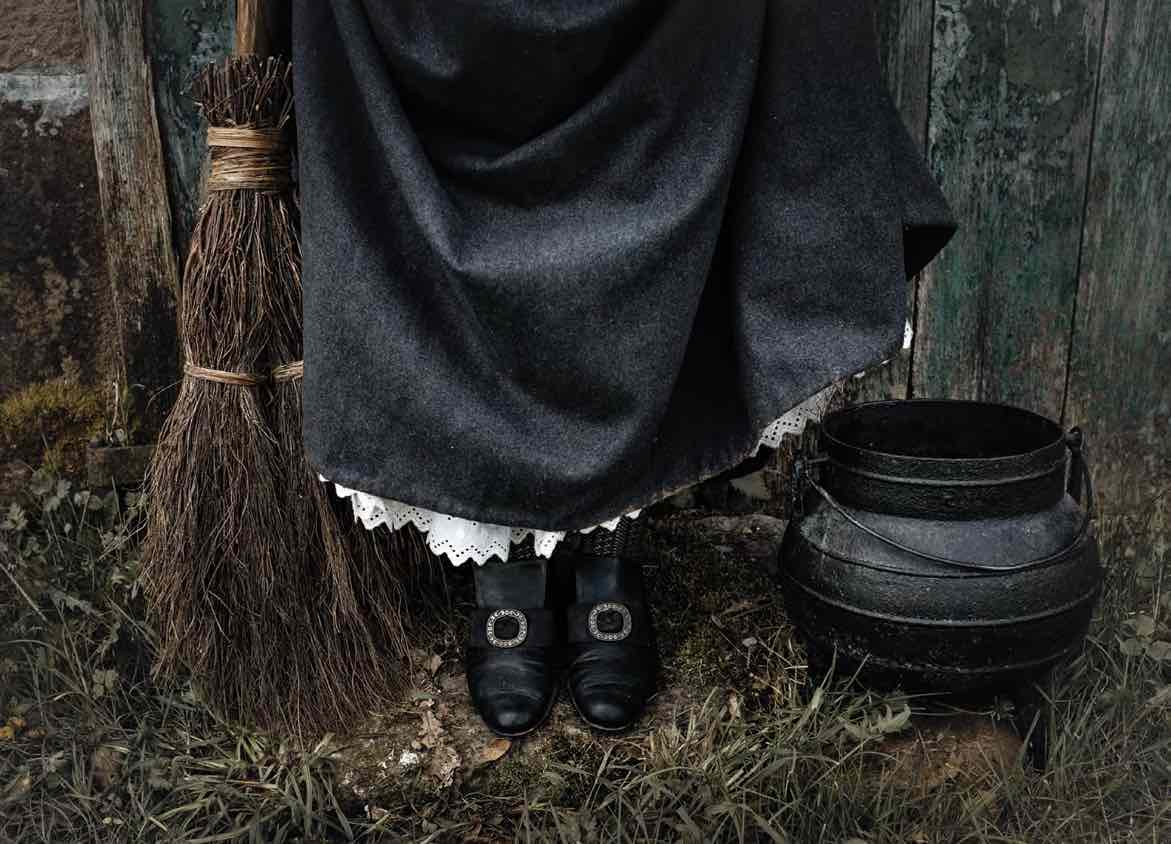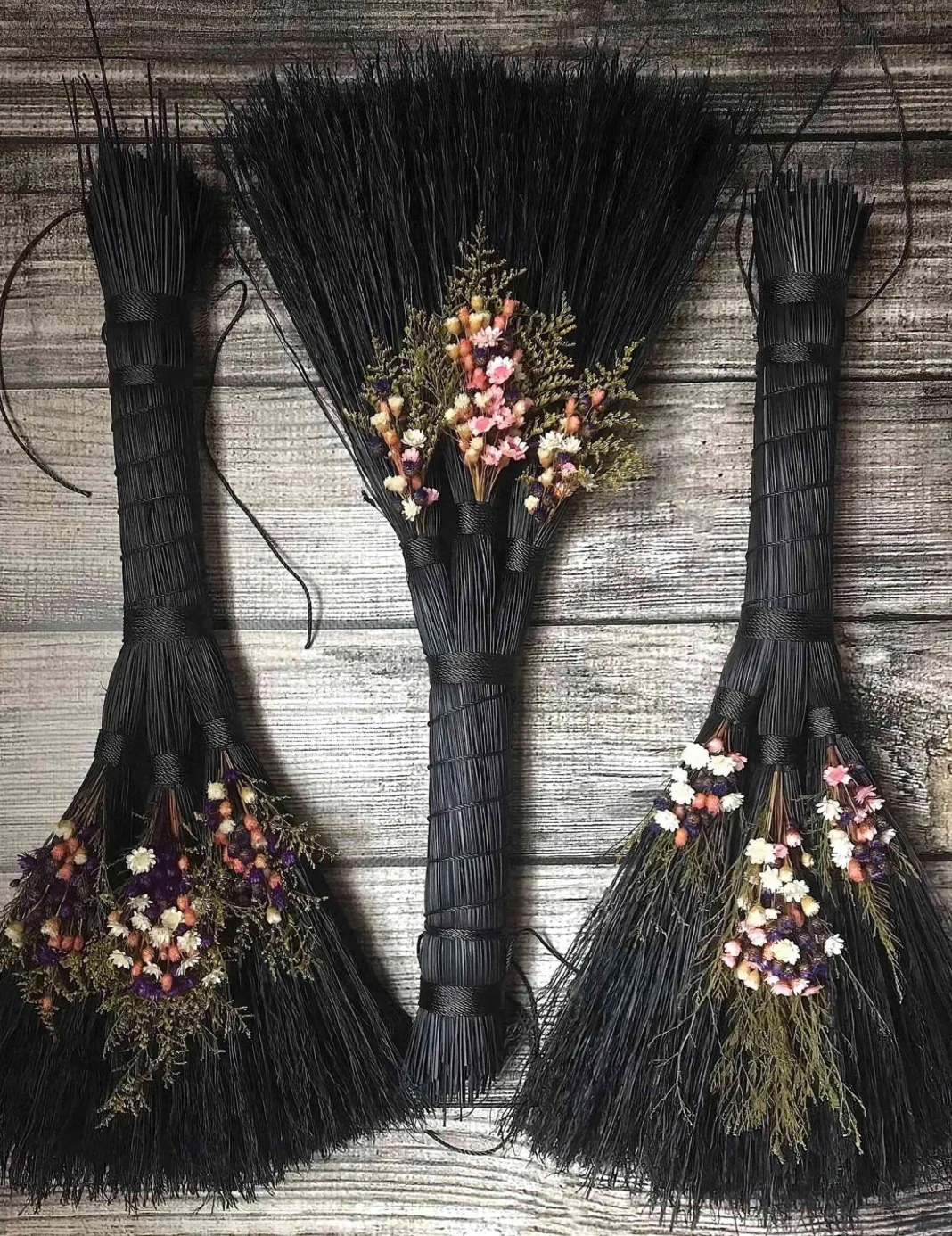How can one not love the humble broom, the most mundane of household instruments and one of the most powerful symbols of witchcraft and magic?
Who of us didn’t, as a child, straddle a broom and imagine ourselves hurtling through a night sky, preferably with a kitty cat (or two) in tow? We love how with a broom you can clean your floor of literal dirt but also sweep from your life all bad vibes and bring into it all manner of abundance, as long as you sweep with intent … and possibly an herb or two. And right now you can find a variety of gorgeous, witchy artists handcrafting brooms that sell out immediately online, and you can, if you’re up for it, make your own. (You can peruse our past witch issues for some lovely tutorials.) Below we talk to three different broom makers whose work we love: one in Hudson Valley, New York, one in the Texas Hill Country, and one in a rural area of the Basque Country in France.
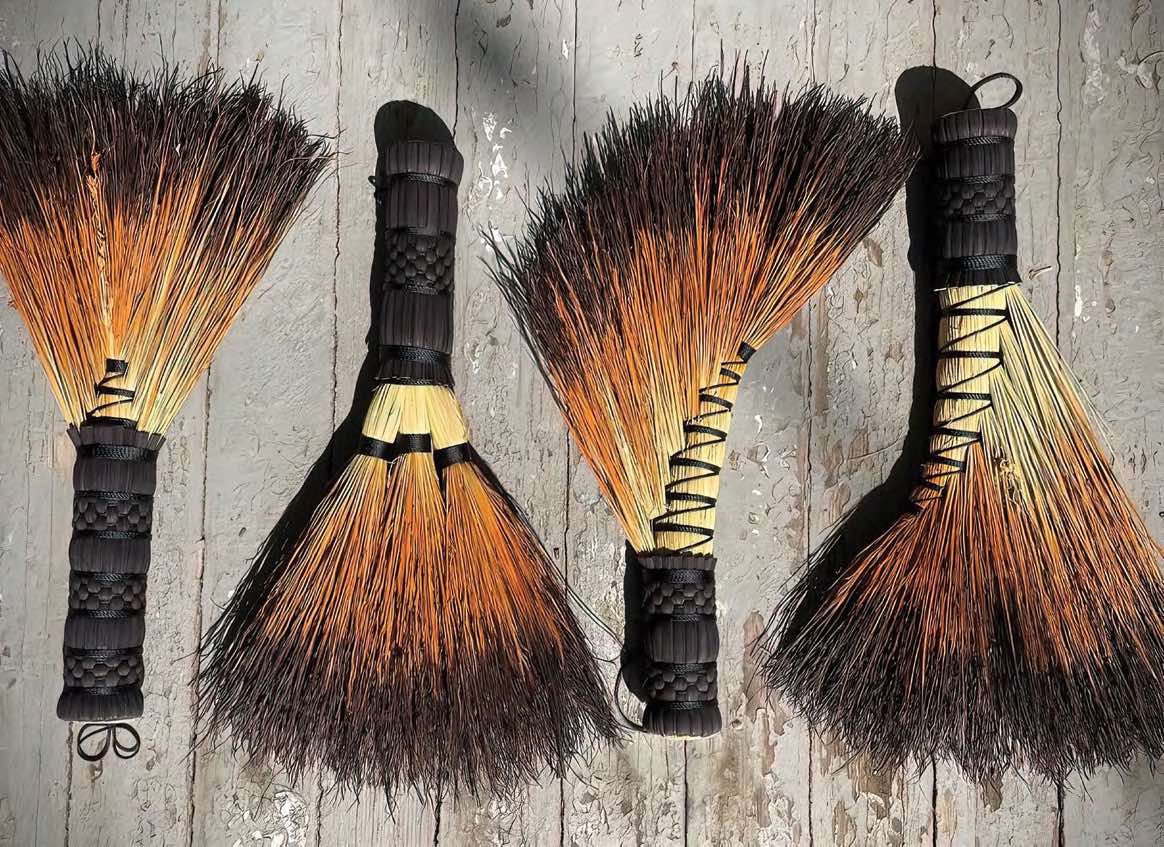
PASKALINI SAVOPOULOS
broomsquire at Vagabond Spun
Why did you start making brooms?
I fell in love with and purchased my first handmade broom at our local Renaissance Festival here in New York. It really made me stop and reconsider this humble tool. I, as I find many people are, was in awe that this item we take utterly for granted was made by hand and was so beautiful. A couple of years later I learned about a broom making workshop at the John C. Campbell Folk School in North Carolina and ended up spending a week there learning traditional Appalachian broomcraft from master broom maker Marlow Gates. I lived in that workshop for as many hours a day as Marlow and his assistant would allow. I was absolutely hooked. I made as many brooms as I could. Being a baby broom maker who’d never whittled a stick or used a saw ever meant I didn’t make many, but I wanted to remember everything and build as much muscle memory as possible while I had the guidance to correct any potential mistakes. When I got home, a dear friend knew I was going to take this as far as
I could, and her husband made me a beautiful foot brake—broom spindle, foot winder, there are many terms for the tool—so I could continue to make brooms from home. I’ve been making brooms ever since.
What does it mean to you, making brooms by hand?
Honestly I adore working hands and handmade things. Making brooms by hand means that each broom has its own personality. Each piece is individually considered as it comes to life. It allows me a deeper connection to nature as I walk the woods or shores of the river in search of handles. Broomcraft came to me while I was still very much in the broom closet and has brought me community in so many ways. It’s pushed me to learn new skill sets to elevate my offerings. It has also allowed me to dig deeper into my practice. When I’m called to make something special, perhaps concerning ritual or deities, I like to read a lot about what I’m working with to see how I can bring that to the piece. For me, making brooms by hand is an expression of love.
Who is your customer?
My customer is anyone who finds joy in a handmade item. I try not to isolate my work to active practitioners only, and I never want anyone to feel they can’t purchase a broom because they don’t have a practice. I make each piece knowing that there is a person for every broom, and I do not assign intention to them, rather I allow them to find their person and allow that person to assign intention to their piece. People often ask in my booth, “What is this one for?” And I reply, “Well, it depends on who takes it home.” I’ll offer some examples of how others have told me they use similar pieces.
How do you define a witch?
That’s a tricky question. There are so many ways to begin to define a witch, and at the same time it’s incredibly difficult. For me a witch is someone who seeks connection with nature and natural rhythms—someone who has recognized that there are energies at work in the universe and has decided to commit themselves to paying attention to those energies, learning how to manipulate and apply them in their lives to help guide them along their path to become the truest version of who they were meant to be.
How do you stay enchanted in everyday life?
My everyday life can get really hectic, and it’s easy to get overwhelmed. I have a lovely smudge spray from Houss Freya that I use daily. It helps ground me and even if I’m feeling blah in the morning the scent brings me comfort and helps me mentally prepare for my day. Otherwise I keep small bits of magic everywhere—crystals in pockets, hand-gathered herbs hanging in my car, leaves, feathers and other things that I’ve collected on most surfaces in any space I occupy. Just little daily reminders of time spent connecting with nature.
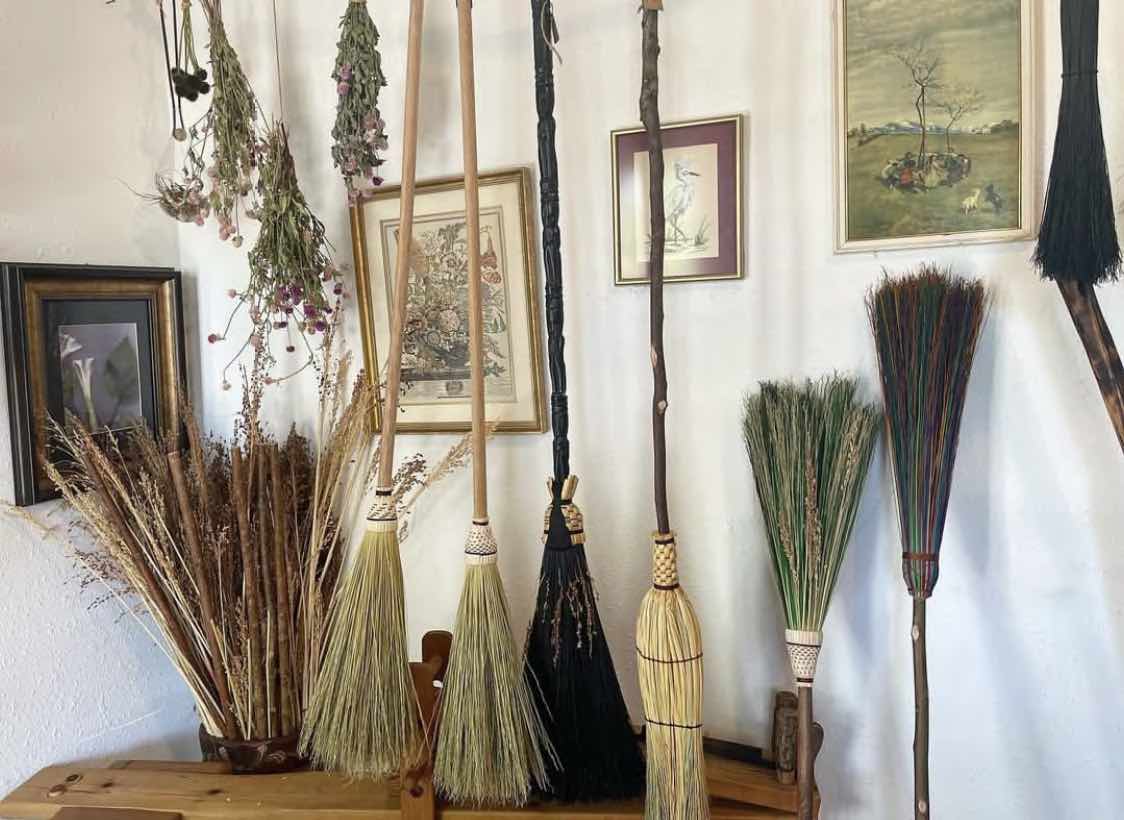

NAM JOTI KAUR KHALSA
owner of Blue Cypress School of Holism
Why did you start making brooms?
I had a dream around 2011 that included a message about sweeping
the floor. In it, I asked a Qi Gong master, “What is the path to enlightenment?” And he answered, “To reach enlightenment, you must sweep the floor.” That started me on a quest to understand what
it means to “sweep the floor,” on many levels. There’s physically sweeping the floor, literally cleaning out your house with something that came from the earth. Sweeping the floor is also an act of meditation, a sacred practice that grounds us. There are the old habits and patterns we get stuck in and need to clear. There’s work we can do within our communities … This is where my fascination with brooms comes from, I think.
I wanted to learn to make brooms myself but was unable to find a class or resources, so I tried teaching myself to make a kitchen broom with wire. I was proud and hung it on the wall, but the broom was not functional. Then my husband surprised me one birthday with a shave horse (a traditional workbench), and when we went to pick it up from the man selling it, my husband told him I wanted to learn to make brooms. The man said that his wife was a broom maker. I was shocked. His wife came outside and ended up showing us her studio. When she opened the door, there were brooms hanging everywhere, on every wall, all kinds of brooms in various states of completion, and shelves and shelves of broomcorn, fiber, and other supplies. I cried. Sometimes when you’re determined, the universe puts what you need right in your path. The woman, Karen Hobbs, ended up teaching me broom making for the next year and a half, before she died. Meeting her changed the course of my life. Now every broom I make is in honor of her.
What does it mean to you, making brooms by hand?
Making brooms by hand connects me with something old, as old as the earth and the people who inhabit it. It gives me purpose and is an incredible outlet for creativity, spirituality, and magic. Now I’m teaching my three children—they’re ages thirteen, sixteen, and seventeen—to make brooms by hand. I believe my youngest son will be the one to become a full-time broomsquire (someone who makes a living from making and selling handmade brooms).
Who is your customer?
Anyone and everyone. Who doesn’t work with brooms in one way or another? Last year I opened my store, Wabi Sabi Broom Shop, in my hometown of Wimberley, Texas. It was my youngest son’s idea to turn an old office space into a broom shop. There I meet all kinds of people looking for old-world brooms—tourists who want a souvenir from our small river town, new homeowners shopping for a kitchen broom (“never take an old broom into a new home”), young witches looking for altar brooms, older people who remember their grandmothers using pieces of broomcorn to test their cakes, and locals who want to support the artists in their area.
What else do you make? Please tell us about all your endeavors!
I also own a school and an apothecary, and make herbal formulations, heirloom corn husk dolls, hand-sewn goods, plant- dyed and eco-printed clothing, and whatever else my imagination leads me toward.
Do you consider yourself a witch?
I do consider myself a witch but only by my own definition.
In my opinion, a witch is someone who walks close to the earth, is in relationship with the medicine and wisdom of plants, and works the magic of alchemy (transforming lead to gold) on the self.
How do you stay enchanted in everyday life?
This human existence is fleeting and death is ever present. It is a miracle that any of us are even here at all. And that is enchanting to me.
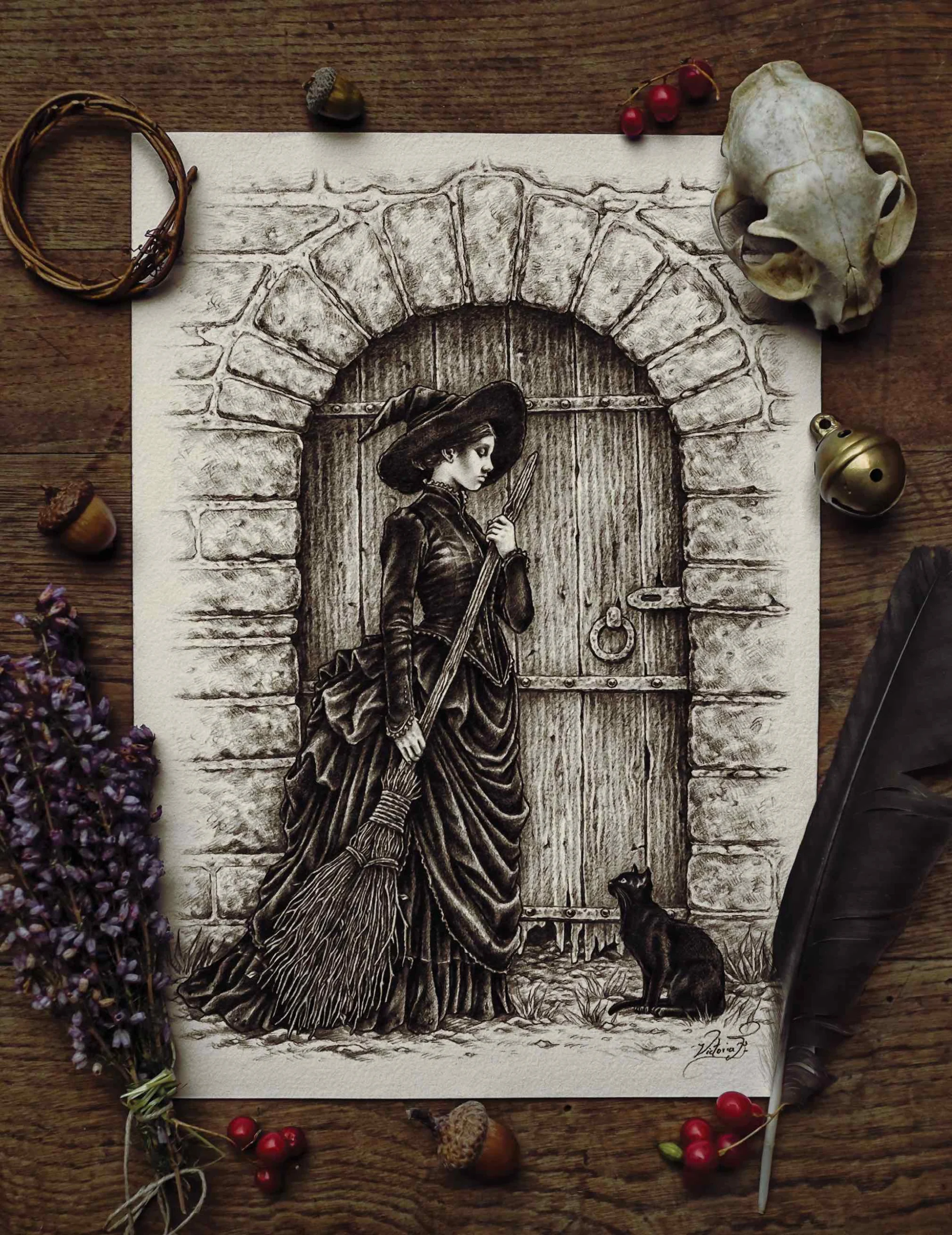
VICTORIA FRANCÉS
artist
Why did you start making brooms?
I’ve always had a passion for everything related to the witch’s world. When I was a child, I used to dream about flying through the skies on a broomstick, just like the witches did in fairy tales. My childhood drawings are a pure example of this! Later on, when I actually got into the practice of traditional witchcraft, I started to become more interested in folklore, mainly the lore and legends related to the area I live in and also the traditional ways our ancestors made their tools. This is how I started to make besoms in a traditional way, specially designed as a ritual tool but also suitable for domestic or decorative use.
What does it mean to you, making brooms by hand?
For me, making brooms by hand is a way to recover a very old craft and tradition that might otherwise be set aside. In this way, I also try to offer that special charm so connected to the rural life and the ancient times when objects were more than just mere tools.
Who is your customer?
Customers that are interested in my brooms vary a lot: It could be a practitioner of witchcraft or sorcery, a museum interested in traditional tools associated with the rural way of life, someone who wants to dress up in a classical witch costume for Halloween, or even a person who simply appreciates the handcrafts elaborated with charm, far away from the cold industrial manufacturing that dominates the world today.
What else do you make? Please tell us about all your endeavors!
Mainly I’ve been a professional illustrator for more than twenty years.
I consider myself to be a storyteller and author of illustrated albums. I also enjoy living firsthand the world that my art reflects, which brings me a total coherence with the way I understand life and my personal beliefs.
Do you consider yourself a witch?
I would define myself more as a practitioner of hedge witchcraft, in constant learning and evolution, and with an avid interest in the field of ethnobotany and folklore.
How do you stay enchanted in everyday life?
I’ve always tried to join my personal life with the way I express myself artistically. To make this a reality, I absolutely felt the need to live in the most rural environment possible, where the local customs, the folklore, and the study of legends were more accessible for me. This made it easier for me to develop my animistic view of nature, being in direct connection to it in its pure wild and untamed stage. I’d say that this is the real magic for me—and I can no longer live without it.
What advice would you have for those looking to live a more magical life?
I believe that one of the keys to having a connection with the magical and the arcane is, first and foremost, to know how to identify or interpret the several signs that life offers us during our existence. For this to happen, a sincere compromise with ourselves is essential. Then we can start practicing magical thinking to extricate ourselves from the excessively rationalist belief system that oppresses us spiritually and that we inherited from the Enlightenment. After opening our eyes to that other reality, which has always existed and has never abandoned us, everything will start to change in a radical way—and magic will form part of our lives. i
